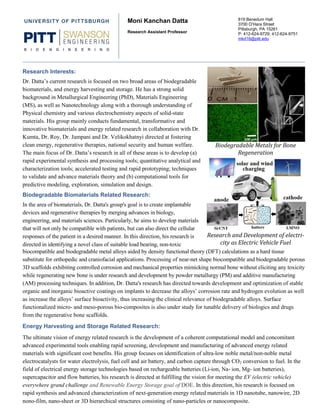Report
Share
Download to read offline

Recommended
Recommended
Carbon Nanomaterials: Opening a Path to a Sustainable Future by Jianbo Zhang in Research & Development in Material ScienceCrimson Publishers-Carbon Nanomaterials: Opening a Path to a Sustainable Future

Crimson Publishers-Carbon Nanomaterials: Opening a Path to a Sustainable FutureCrimsonPublishersRDMS
More Related Content
Similar to Datta-bioengg-faculty booklet-final-3
Carbon Nanomaterials: Opening a Path to a Sustainable Future by Jianbo Zhang in Research & Development in Material ScienceCrimson Publishers-Carbon Nanomaterials: Opening a Path to a Sustainable Future

Crimson Publishers-Carbon Nanomaterials: Opening a Path to a Sustainable FutureCrimsonPublishersRDMS
Similar to Datta-bioengg-faculty booklet-final-3 (20)
Multifunctional carbon nitride nanoarchitectures for catalysis

Multifunctional carbon nitride nanoarchitectures for catalysis
Recent advances in ultra-low temperature (sub-zero to 100 8C) synthesis, mech...

Recent advances in ultra-low temperature (sub-zero to 100 8C) synthesis, mech...
Current state and Prospects of Materials Science Research - Phdassistance

Current state and Prospects of Materials Science Research - Phdassistance
BIOMEDICAL APPLICATIONS OF CERAMIC NANOMATERIALS: A REVIEW

BIOMEDICAL APPLICATIONS OF CERAMIC NANOMATERIALS: A REVIEW
Sustainable synthesis of nanoscale zerovalent iron particles for environmenta...

Sustainable synthesis of nanoscale zerovalent iron particles for environmenta...
Crimson Publishers-Carbon Nanomaterials: Opening a Path to a Sustainable Future

Crimson Publishers-Carbon Nanomaterials: Opening a Path to a Sustainable Future
Adaptation of Biomimicry in Structural Engineering | IUT Ceenovation

Adaptation of Biomimicry in Structural Engineering | IUT Ceenovation
Datta-bioengg-faculty booklet-final-3
- 1. Moni Kanchan Datta Research Assistant Professor 819 Benedum Hall 3700 O’Hara Street Pittsburgh, PA 15261 P: 412-624-9729; 412-624-9751 mkd16@pitt.edu Biodegradable Metals for Bone Regeneration Research and Development of electri- city as Electric Vehicle Fuel Research Interests: Dr. Datta’s current research is focused on two broad areas of biodegradable biomaterials, and energy harvesting and storage. He has a strong solid background in Metallurgical Engineering (PhD), Materials Engineering (MS), as well as Nanotechnology along with a thorough understanding of Physical chemistry and various electrochemistry aspects of solid-state materials. His group mainly conducts fundamental, transformative and innovative biomaterials and energy related research in collaboration with Dr. Kumta, Dr. Roy, Dr. Jampani and Dr. Velikokhatnyi directed at fostering clean energy, regenerative therapies, national security and human welfare. The main focus of Dr. Datta’s research in all of these areas is to develop (a) rapid experimental synthesis and processing tools; quantitative analytical and characterization tools; accelerated testing and rapid prototyping; techniques to validate and advance materials theory and (b) computational tools for predictive modeling, exploration, simulation and design. Biodegradable Biomaterials Related Research: In the area of biomaterials, Dr. Datta's group's goal is to create implantable devices and regenerative therapies by merging advances in biology, engineering, and materials sciences. Particularly, he aims to develop materials that will not only be compatible with patients, but can also direct the cellular responses of the patient in a desired manner. In this direction, his research is directed in identifying a novel class of suitable load bearing, non-toxic biocompatible and biodegradable metal alloys aided by density functional theory (DFT) calculations as a hard tissue substitute for orthopedic and craniofacial applications. Processing of near-net shape biocompatible and biodegradable porous 3D scaffolds exhibiting controlled corrosion and mechanical properties mimicking normal bone without eliciting any toxicity while regenerating new bone is under research and development by powder metallurgy (PM) and additive manufacturing (AM) processing techniques. In addition, Dr. Datta's research has directed towards development and optimization of stable organic and inorganic bioactive coatings on implants to decrease the alloys’ corrosion rate and hydrogen evolution as well as increase the alloys’ surface bioactivity, thus increasing the clinical relevance of biodegradable alloys. Surface functionalized micro- and meso-porous bio-composites is also under study for tunable delivery of biologics and drugs from the regenerative bone scaffolds. Energy Harvesting and Storage Related Research: The ultimate vision of energy related research is the development of a coherent computational model and concomitant advanced experimental tools enabling rapid screening, development and manufacturing of advanced energy related materials with significant cost benefits. His group focuses on identification of ultra-low noble metal/non-noble metal electrocatalysts for water electrolysis, fuel cell and air battery, and carbon capture through CO2 conversion to fuel. In the field of electrical energy storage technologies based on rechargeable batteries (Li-ion, Na- ion, Mg- ion batteries), supercapacitor and flow batteries, his research is directed at fulfilling the vision for meeting the EV (electric vehicle) everywhere grand challenge and Renewable Energy Storage goal of DOE. In this direction, his research is focused on rapid synthesis and advanced characterization of next-generation energy related materials in 1D nanotube, nanowire, 2D nono-film, nano-sheet or 3D hierarchical structures consisting of nano-particles or nanocomposite.